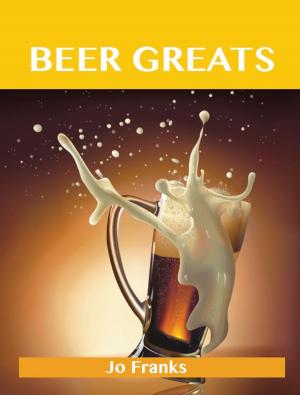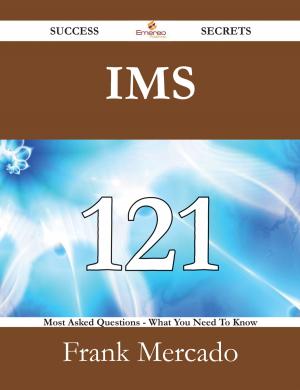| Author: | Peggy Steven | ISBN: | 9781486427499 |
| Publisher: | Emereo Publishing | Publication: | October 24, 2012 |
| Imprint: | Emereo Publishing | Language: | English |
| Author: | Peggy Steven |
| ISBN: | 9781486427499 |
| Publisher: | Emereo Publishing |
| Publication: | October 24, 2012 |
| Imprint: | Emereo Publishing |
| Language: | English |
Here's part of the content - you would like to know it all? Delve into this book today!..... : The equilibrium ratio of orthohydrogen to parahydrogen depends on temperature, but because the ortho form is an excited state and has a higher energy than the para form, it is unstable and cannot be purified.
... Because of its relatively simple atomic structure, consisting only of a proton and an electron, the hydrogen atom, together with the spectrum of light produced from it or absorbed by it, has been central to the development of the theory of atomic structure.
... Hydrogen, as atomic H, is the most abundant chemical element in the universe, making up 75% of normal matter by mass and over 90% by number of atoms (most of the mass of the universe, however, is not in the form of chemical-element type matter, but rather is postulated to occur as yet-undetected forms of mass such as dark matter and dark energy).
... There are more than 200 thermochemical cycles which can be used for water splitting, around a dozen of these cycles such as the iron oxide cycle, cerium(IV) oxide-cerium(III) oxide cycle, zinc zinc-oxide cycle, sulfur-iodine cycle, copper-chlorine cycle and hybrid sulfur cycle are under research and in testing phase to produce hydrogen and oxygen from water and heat without using electricity.
There is absolutely nothing that isn't thoroughly covered in the book. It is straightforward, and does an excellent job of explaining all about Hydrogen in key topics and material. There is no reason to invest in any other materials to learn about Hydrogen. You'll understand it all.
Inside the Guide: Hydrogen, Cadmium oxide, Cadmium, CNO cycle, CAS registry number, CANDU reactor, Butylated hydroxytoluene, Butane, Bubble chamber, Bromous acid, Bromine, Bromic acid, Boron, Borane, Boiling point, Bohr model, Bismuth, Biodiesel, Biochemistry, Big Bang, Bevatron, Berkelium, Barium, Balmer series, Balloon, Autoignition temperature, Atomic number, Atomic nucleus, Atomic mass unit, Atomic hydrogen welding, Atom, Atmospheric escape, Astatine, Asphyxia, Arsenous acid, Arsenic acid, Arsenic, Argon, Antoine Lavoisier, Antioxidant, Antimony, Antihydrogen, Antifreeze, Anaerobic corrosion, Amorphous silicon, Amorphous carbon, Ammonia production, Ammonia, Americium, Aluminium oxide, Aluminium, Alkaline earth metal, Alkali metal, Algae, Airship, Activated carbon, Actinium, Actinide, Acid, Abundance of the chemical elements, 2001 Mars Odyssey, 1,2-Dichloroethane, 1,2-Dibromoethane
Here's part of the content - you would like to know it all? Delve into this book today!..... : The equilibrium ratio of orthohydrogen to parahydrogen depends on temperature, but because the ortho form is an excited state and has a higher energy than the para form, it is unstable and cannot be purified.
... Because of its relatively simple atomic structure, consisting only of a proton and an electron, the hydrogen atom, together with the spectrum of light produced from it or absorbed by it, has been central to the development of the theory of atomic structure.
... Hydrogen, as atomic H, is the most abundant chemical element in the universe, making up 75% of normal matter by mass and over 90% by number of atoms (most of the mass of the universe, however, is not in the form of chemical-element type matter, but rather is postulated to occur as yet-undetected forms of mass such as dark matter and dark energy).
... There are more than 200 thermochemical cycles which can be used for water splitting, around a dozen of these cycles such as the iron oxide cycle, cerium(IV) oxide-cerium(III) oxide cycle, zinc zinc-oxide cycle, sulfur-iodine cycle, copper-chlorine cycle and hybrid sulfur cycle are under research and in testing phase to produce hydrogen and oxygen from water and heat without using electricity.
There is absolutely nothing that isn't thoroughly covered in the book. It is straightforward, and does an excellent job of explaining all about Hydrogen in key topics and material. There is no reason to invest in any other materials to learn about Hydrogen. You'll understand it all.
Inside the Guide: Hydrogen, Cadmium oxide, Cadmium, CNO cycle, CAS registry number, CANDU reactor, Butylated hydroxytoluene, Butane, Bubble chamber, Bromous acid, Bromine, Bromic acid, Boron, Borane, Boiling point, Bohr model, Bismuth, Biodiesel, Biochemistry, Big Bang, Bevatron, Berkelium, Barium, Balmer series, Balloon, Autoignition temperature, Atomic number, Atomic nucleus, Atomic mass unit, Atomic hydrogen welding, Atom, Atmospheric escape, Astatine, Asphyxia, Arsenous acid, Arsenic acid, Arsenic, Argon, Antoine Lavoisier, Antioxidant, Antimony, Antihydrogen, Antifreeze, Anaerobic corrosion, Amorphous silicon, Amorphous carbon, Ammonia production, Ammonia, Americium, Aluminium oxide, Aluminium, Alkaline earth metal, Alkali metal, Algae, Airship, Activated carbon, Actinium, Actinide, Acid, Abundance of the chemical elements, 2001 Mars Odyssey, 1,2-Dichloroethane, 1,2-Dibromoethane















